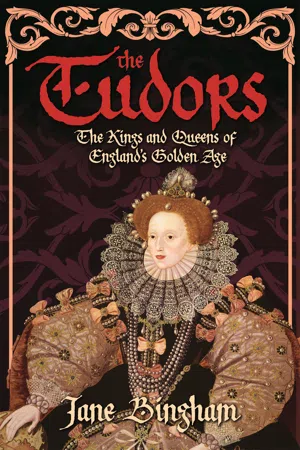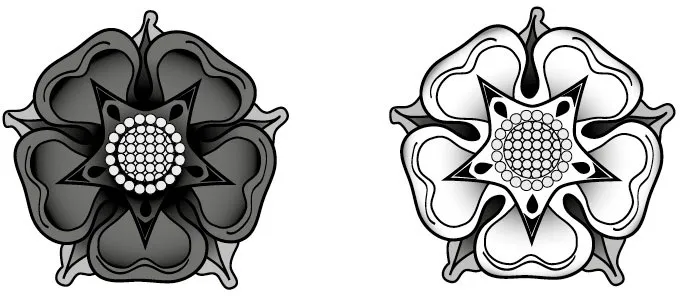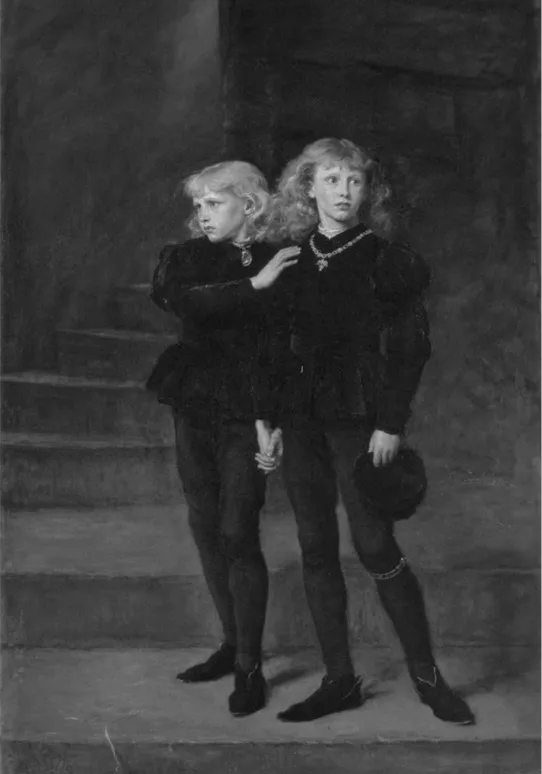
This is a test
- English
- ePUB (mobile friendly)
- Available on iOS & Android
eBook - ePub
Book details
Book preview
Table of contents
Citations
About This Book
The Tudors were an unforgettable dynasty who wielded absolute power during a remarkably turbulent time in English history. Each ruler's survival required a fierce struggle to maintain control - often against incredible odds.From Henry VII, England's last king to win the crown in battle, and the tyrannical Henry VIII with his succession of wives, to the fiercely Catholic 'Bloody Mary', and her sister, Elizabeth, the 'Virgin queen', Jane Bingham examines just how fairly history has treated these Tudor rulers.Both as politicians and as individuals, it is no wonder these larger-than-life monarchs still capture our imaginations today.
Frequently asked questions
At the moment all of our mobile-responsive ePub books are available to download via the app. Most of our PDFs are also available to download and we're working on making the final remaining ones downloadable now. Learn more here.
Both plans give you full access to the library and all of Perlego’s features. The only differences are the price and subscription period: With the annual plan you’ll save around 30% compared to 12 months on the monthly plan.
We are an online textbook subscription service, where you can get access to an entire online library for less than the price of a single book per month. With over 1 million books across 1000+ topics, we’ve got you covered! Learn more here.
Look out for the read-aloud symbol on your next book to see if you can listen to it. The read-aloud tool reads text aloud for you, highlighting the text as it is being read. You can pause it, speed it up and slow it down. Learn more here.
Yes, you can access The Tudors by Jane Bingham in PDF and/or ePUB format, as well as other popular books in History & British History. We have over one million books available in our catalogue for you to explore.
Information
Chapter 1
Fighting for the Crown
The battlefield at Bosworth was scattered with the bodies of the wounded, dead and dying. For almost three hours, the armies of York and Lancaster had fought tenaciously, but now the bloody struggle was over. And in the midst of the carnage lay King Richard III, the last English monarch to die in battle.
Richard had worn his crown proudly into battle, and as he lay dying – so the chroniclers said – it had rolled away under a hawthorn bush. When the fighting was done, the muddy crown was rescued and placed on the head of the young victor. It was a crucial moment in English history. As Henry Tudor accepted the English crown, the Wars of the Roses came to an end and the Tudor era began.
The dynasty that Henry Tudor founded would rule for more than a hundred years, presiding over a golden age of music, art and literature. Under the Tudors, England experienced peace and prosperity, transforming itself from an obscure northern kingdom into a major player in European politics. But who was Henry Tudor and how did he come to claim the English throne?
The Wars of the Roses – Fighting for the Crown
Between the years 1455 and 1485 a bitter power struggle was waged between two branches of the Plantagenet dynasty of the English royal family, each branch descended from King Edward III. On one side were the descendants of the Duke of Lancaster, whose supporters wore a red rose emblem. On the other were the offspring of the Duke of York, who sported a white rose. Over a turbulent period of thirty years the English people were ruled by one Lancastrian king – Henry VI – and three Yorkist rulers – Edward IV, Edward V and Richard III. The last major clash of the Wars of the Roses took place on 22 August 1485 at Bosworth Field, close to the town of Bosworth in what is now Leicestershire, when Henry Tudor, heir to the House of Lancaster, defeated the Yorkist king, Richard III.
Who was Henry Tudor?
On 28 January 1457, a puny baby boy struggled into the world in a draughty chamber at Pembroke Castle in Wales. It was not a promising start for a future king. His father, Edmund Tudor, Earl of Richmond, had already been dead three months, and his mother, Margaret Beaufort, was little more than a child. Margaret was only 13 years old when she gave birth to Henry, and the strain of childbirth nearly killed her. Neither Margaret nor Henry was expected to live, but against the odds they both survived. Mother and child stayed on at Pembroke Castle under the care of Lord Stafford, who lost no time in marrying his own son to the young widow. Within three months of Henry’s birth, he had a stepfather, in the shape of the English aristocrat Henry Stafford.
In their remote Welsh castle, Henry and his mother were far removed from the English court, but they could not remain unaffected by the turmoil waging there. The Wars of the Roses had begun two years before Henry’s birth as a result of Richard Duke of York’s claims to the English throne, and one of the struggle’s early victims was Henry’s father. Edmund Tudor had been fighting for the House of Lancaster in 1456 when he was captured by Yorkist supporters and thrown into prison. In the dungeons of Carmarthen Castle in Wales, Edmund contracted plague and died. His son must have grown up listening to horror stories of these bloody wars and their bitter legacy.

Henry Tudor’s links with the House of Lancaster were strong, albeit tinged with scandal. His mother, Margaret Beaufort, could claim royal ancestry, and his father, uncle and grandfather, Edmund, Jasper and Owen Tudor, were passionate supporters of the Lancastrian cause. But his position close to the House of Lancaster was fraught with danger. By the time of Henry Tudor’s birth, power was slipping from the grasp of the reigning Lancastrian monarch, King Henry VI, and none of the king’s relatives was safe from potential harm. As a junior member of the House of Lancaster, young Henry Tudor was destined to be a valuable pawn in some highly dangerous political games.

The red rose of the House of Lancaster, on the left and the white rose of the House of York, on the right.
Henry’s Royal Ancestry – Loose Connections
More than a whiff of scandal clung to Henry Tudor’s royal connections. His mother, Margaret, was directly descended from John Beaufort, the illegitimate child of John of Gaunt, Duke of Lancaster, and third surviving son of King Edward III. On his father’s side, Henry’s grandfather, Owen Tudor, had been clerk of the wardrobe to Katherine of Valois, wife of King Henry V. Owen’s position involved keeping the queen’s domestic accounts, and in the course of his job he developed a close friendship with his royal mistress. After the king’s early death, Owen secretly married Katherine and fathered four children with her, including Henry’s father, Edmund, who were half-brothers and sisters to King Henry VI. Such questionable connections were not to be flaunted, and even after he had won the English crown, Henry Tudor never stressed his claim to the throne.
A Troubled Childhood
Henry’s first experience of adult power games came when he was just four years old. In 1461, his closest male relatives – his uncle Jasper and grandfather Owen Tudor – engaged in a life-and-death struggle to defend their king, leading the Lancastrian forces at the Battle of Mortimer’s Cross, a site near Wigmore in Herefordshire. Their army was soundly defeated, and the Lancastrian King Henry VI was replaced by the Yorkist King Edward IV. Once securely in power, the Yorkists lost no time in executing Owen Tudor, although his son Jasper managed to escape, travelling first to Scotland and then to France.
With his grandfather dead, and his uncle in exile, the four-year-old Henry was left without a guardian and protector. But another dominant figure quickly took over this role. As one of the leading Yorkist nobles in Wales, Sir William Herbert was in a very powerful position, and he seized the chance to take control of a potentially valuable young ward. Henry was welcomed into the Herbert family home in Raglan Castle, south-east Wales, and a new era in his childhood began. The move marked the start of a long period of separation from his mother for Henry, as Margaret moved to England with her husband, Henry Stafford.
Apparently the Herbert family treated young Henry well. He was allowed to keep his title, Earl of Richmond (inherited from his father), and was provided with a good education. There was even talk of Henry marrying Herbert’s daughter, but this peaceful way of life was not to last. In 1469, when Henry was 12 years old, Sir William Herbert was defeated at the Battle of Edgecote Moor, and was later executed by the all-powerful Earl of Warwick (popularly known as the ‘Kingmaker’). In the following year, the Lancastrian monarch, Henry VI, was restored to the throne and Jasper Tudor returned from exile to take over the role of guardian of his young nephew. At the age of 13, Henry Tudor was presented at the English royal court, where he began a new life as a favoured relative of the king.
All Change
The months that followed must have been a confusing time for young Henry. Bereft of his erstwhile guardian and young companions, he was forced to forget his Yorkist adopted family and put his Welsh childhood firmly behind him as he was catapulted into a world of English power politics. But Henry Tudor’s change of fortune was once again short-lived. Within 12 months of his return to the throne, King Henry VI had been thrown into prison. On 4 May 1471 the Yorkists won a decisive victory at the Battle of Tewkesbury, and in the course of the fighting Henry’s only son and heir, Edward, was killed. Less than three weeks later, King Henry died in the Tower of London (murder was widely suspected) and the Yorkist leader, King Edward IV, returned to the throne. This dramatic turnaround in the fortunes of the House of Lancaster put England securely back in the hands of the Yorkists. It also meant that Henry was the new Lancastrian heir – and in mortal danger from the House of York.
Jasper Tudor lost no time in ferrying his nephew to safety across the English Channel – much to King Edward’s displeasure. In the words of a contemporary Tudor historian, the Italian Polydore Vergil, the king reacted ‘very grievously’ to the news that ‘the only imp now left of Henry VI’s brood’ had escaped his clutches, and offered a generous reward to anyone who could bring the fugitives back to England. But fortunately for Henry, Jasper had found a powerful protector for his nephew. Duke Francis II of Brittany was an independent-minded ruler who refused to be browbeaten by an English king. Ignoring all inducements to hand over his charge, he issued a statement that he would provide protection for Jasper and Henry, so long as they undertook not to lead an attack against King Edward.
Henry in Exile
Henry Tudor remained in exile for 14 years. During his long stay at the Breton court, he must have often gazed longingly across the English Channel. But England under Edward IV was a very dangerous place for a Lancastrian heir. Following his return to the throne in 1471, King Edward had established a strong power base, and with the birth of his two sons, the Yorkist succession seemed invincible. By the time Henry reached his 26th year, he must have resigned himself to a lifetime of semi-captivity. Then everything changed in a few momentous months.
In the spring of 1483, King Edward IV caught a cold. A few weeks later he was dead, at the age of 40. At the time of his death, his eldest son, also called Edward, was just 12 years old, so Edward’s uncle, Richard of Gloucester, was proclaimed Lord Protector of the Realm. Richard’s role was to rule on behalf of the boy king, Edward V, until he was mature enough to assume power in his own right. But within a few months, Edward and his younger brother Richard had been incarcerated in the Tower of London, never to be seen again. The imprisonment and subsequent disappearance of the two princes in the Tower is one of the most notorious incidents in English history – and one that is still debated today. But even before their presumed murder, in an attempt to consolidate his hold on power Richard had had the two young princes declared illegitimate, and himself crowned King Richard III.
Murder in the Tower – Who Was To Blame?
Less than a month after the death of King Edward IV, on 9 April 1483, his eldest son, Edward V, was sent to the Tower of London, where he was joined on 16 June by his younger brother, Richard of Gloucester. At first the two princes were spotted in the courtyard of the Tower, but by the end of summer they had disappeared. The fate of the two Yorkist heirs remains unknown, and it is presumed that they were murdered. But the question remains – who was responsible for their deaths?
Most historians have accused King Richard III of the ruthless murder of his nephews, but others have suggested some intriguing alternative scenarios. Some see the Duke of Buckingham, a close ally of Richard in the early months of his reign, as a likely suspect. A few have suggested that it was Henry Tudor who orchestrated the crime, as a way of removing some significant obstacles to his own claim to the throne.

The 12-year-old boy king, Edward V, and his nine-year old brother, Richard Duke of York, who were believed to have been murdered in the Tower on their uncle’s orders.
King Richard and His Enemies
The reign of King Richard III is one of the most controversial in English history. To 16th-century writers Sir Thomas More and William Shakespeare, Richard Crookbaevck was a deformed villain, perpetrator of foul deeds. Later historians have attempted to rehabilitate his reputation, stressing his popularity among the people of northern England. Some have absolved him of responsibility for the fate of the two princes; Buckingham, once a close ally of Richard’s, is viewed as a more likely suspec...
Table of contents
- Title Page
- Contents
- Chapter 1 • Fighting for the Crown
- Chapter 2 • A Dynasty is Born – the Reign of Henry VII
- Chapter 3 • The Promise of Greatness – Young Henry VIII
- Chapter 4 • Turmoil and Tyranny – the Later Reign of Henry VIII
- Chapter 5 • The Boy King and the Nine Days’ Queen – Edward and Jane
- Chapter 6 • Bloody Mary – the Life and Reign of Mary I
- Chapter 7 • The Making of a Great Queen – Young Elizabeth
- Chapter 8 • The End of the Dynasty – Gloriana
- Epilogue • What was the Tudors’ Legacy?
- Picture Credits
- Copyright